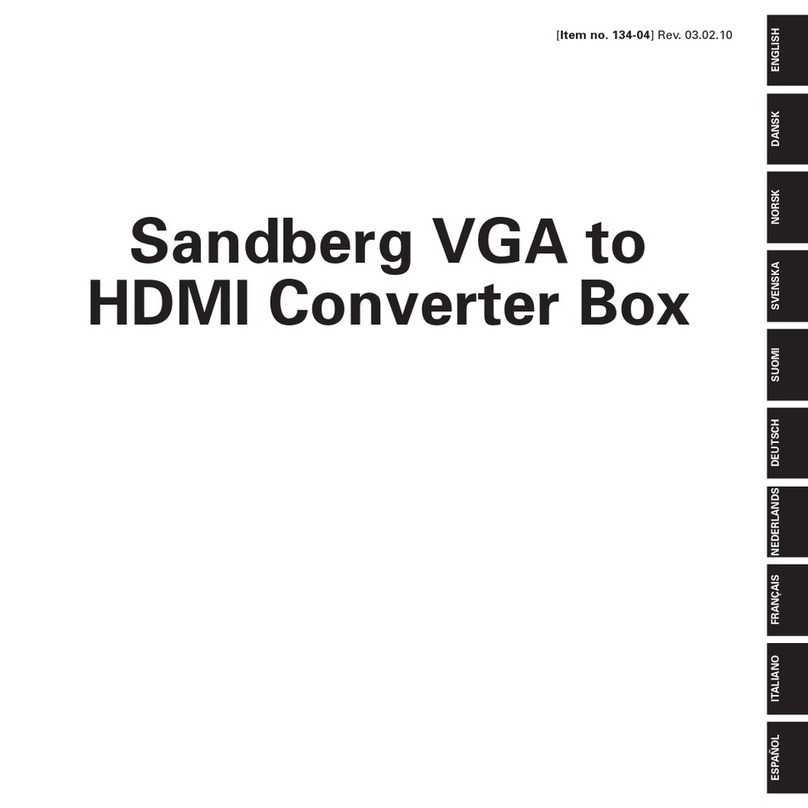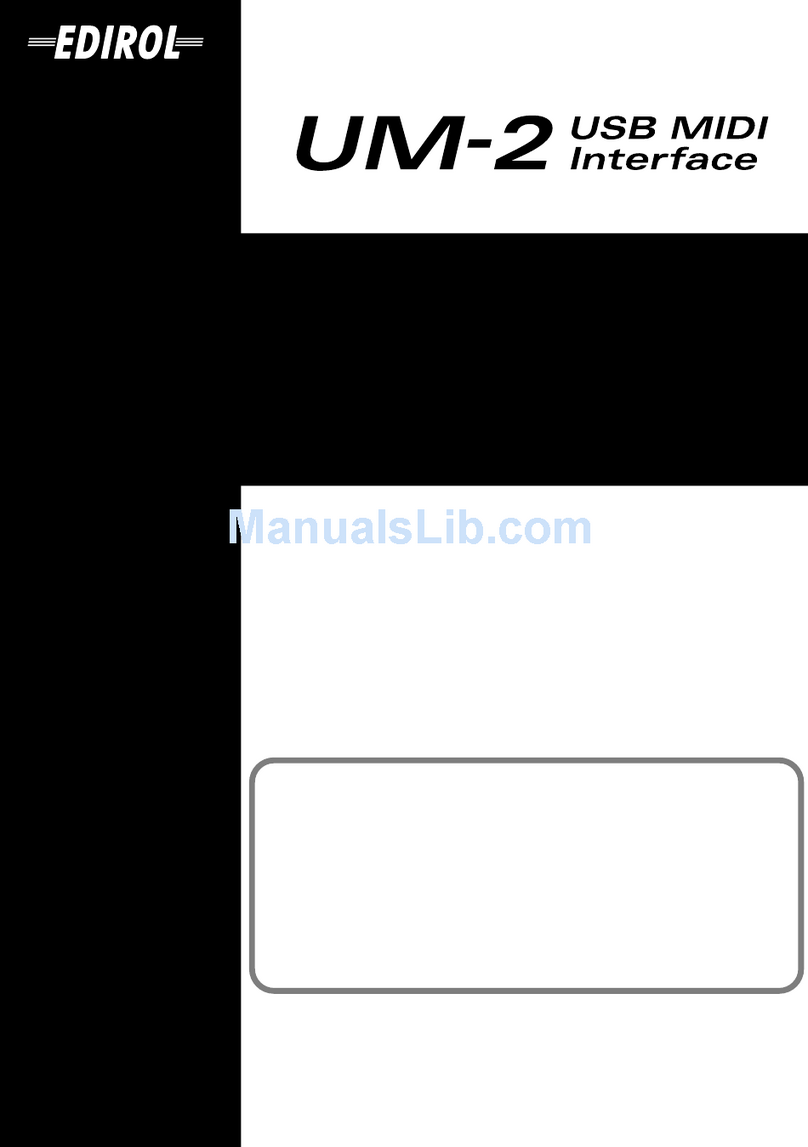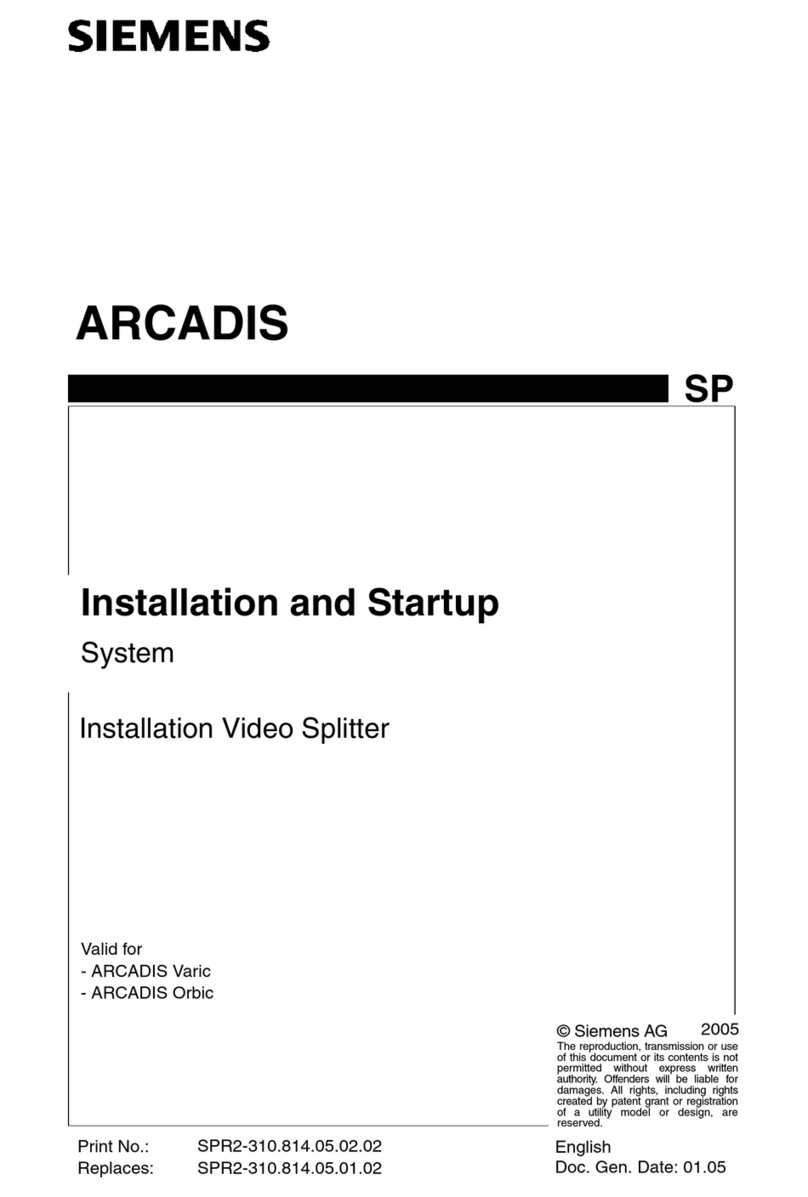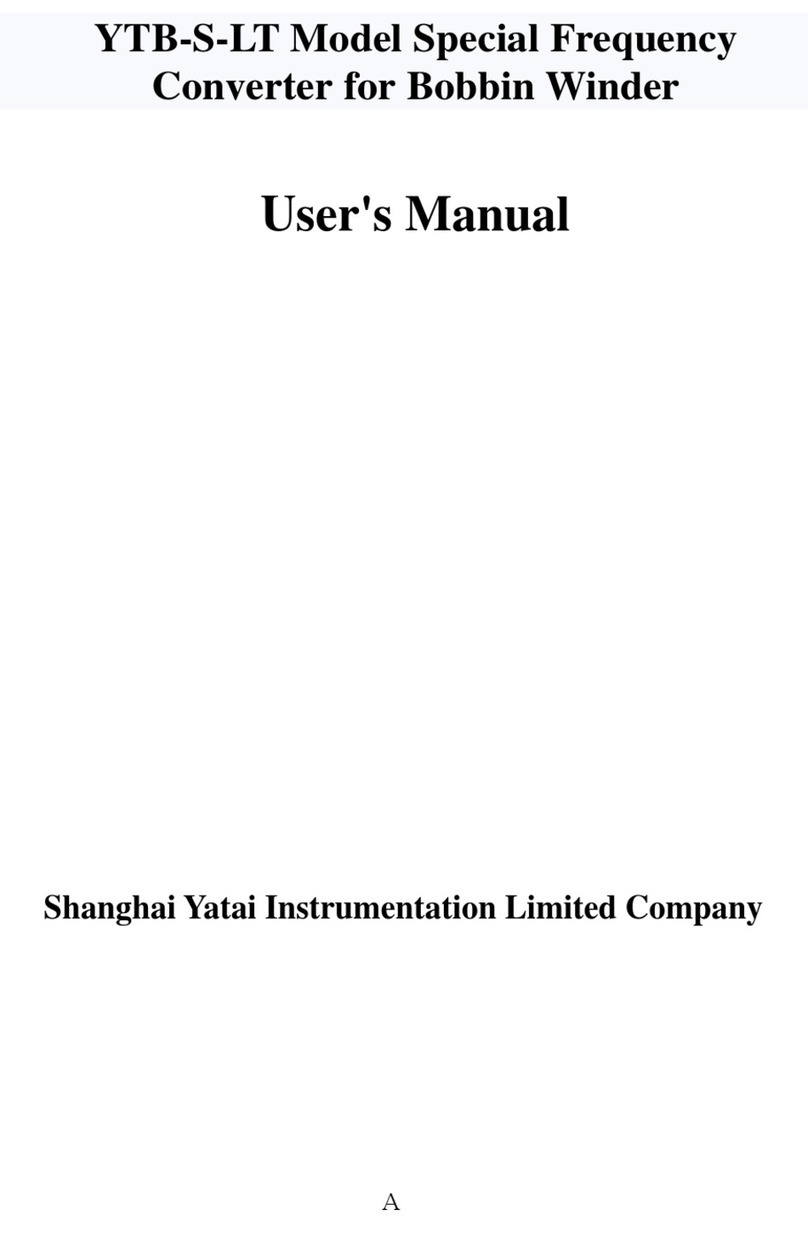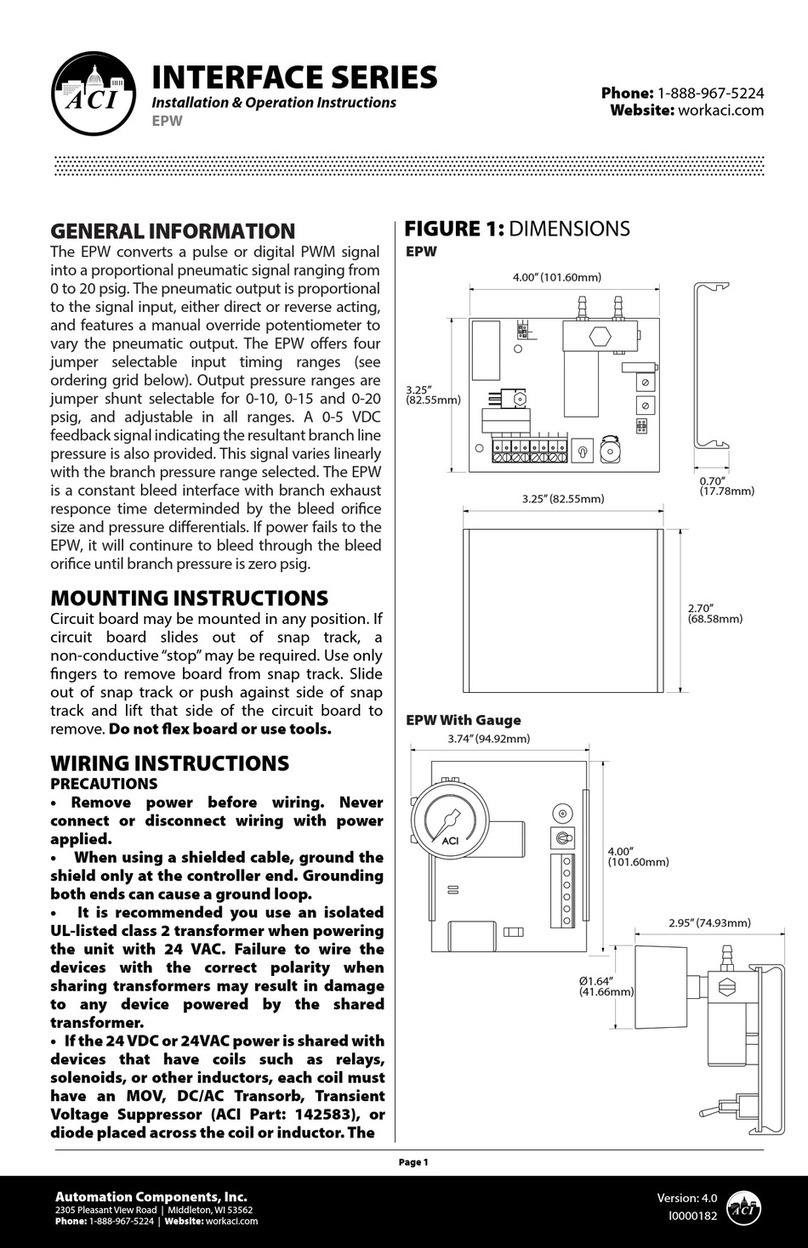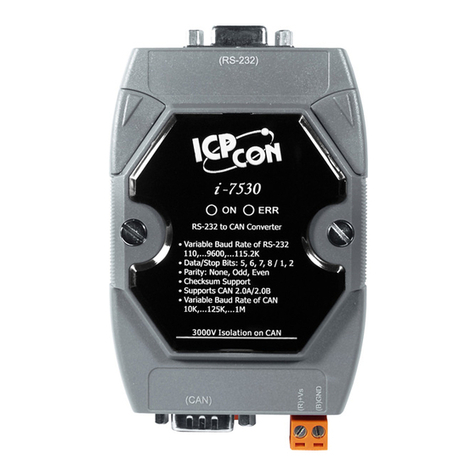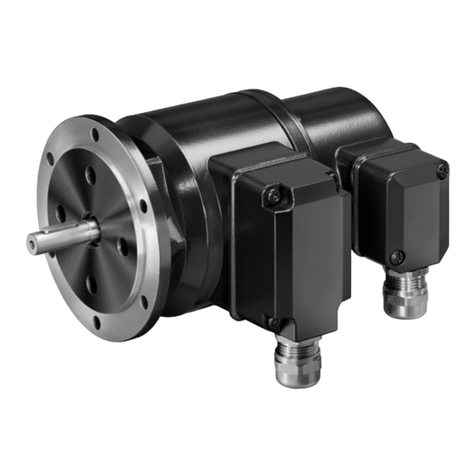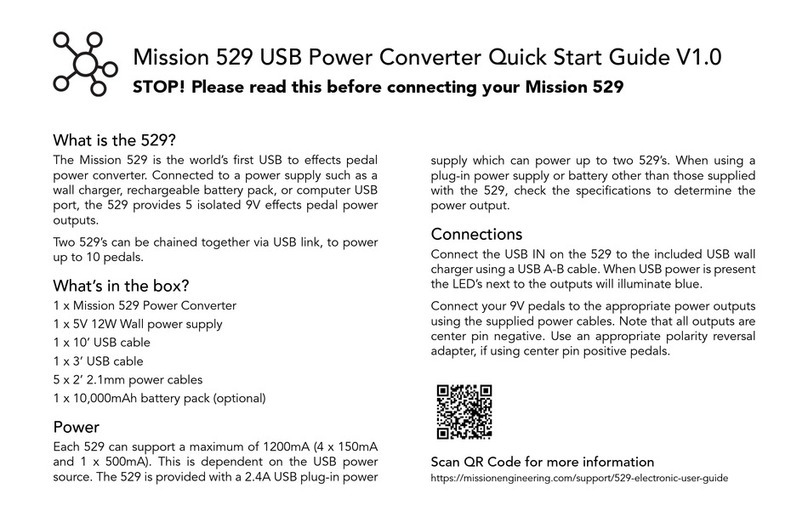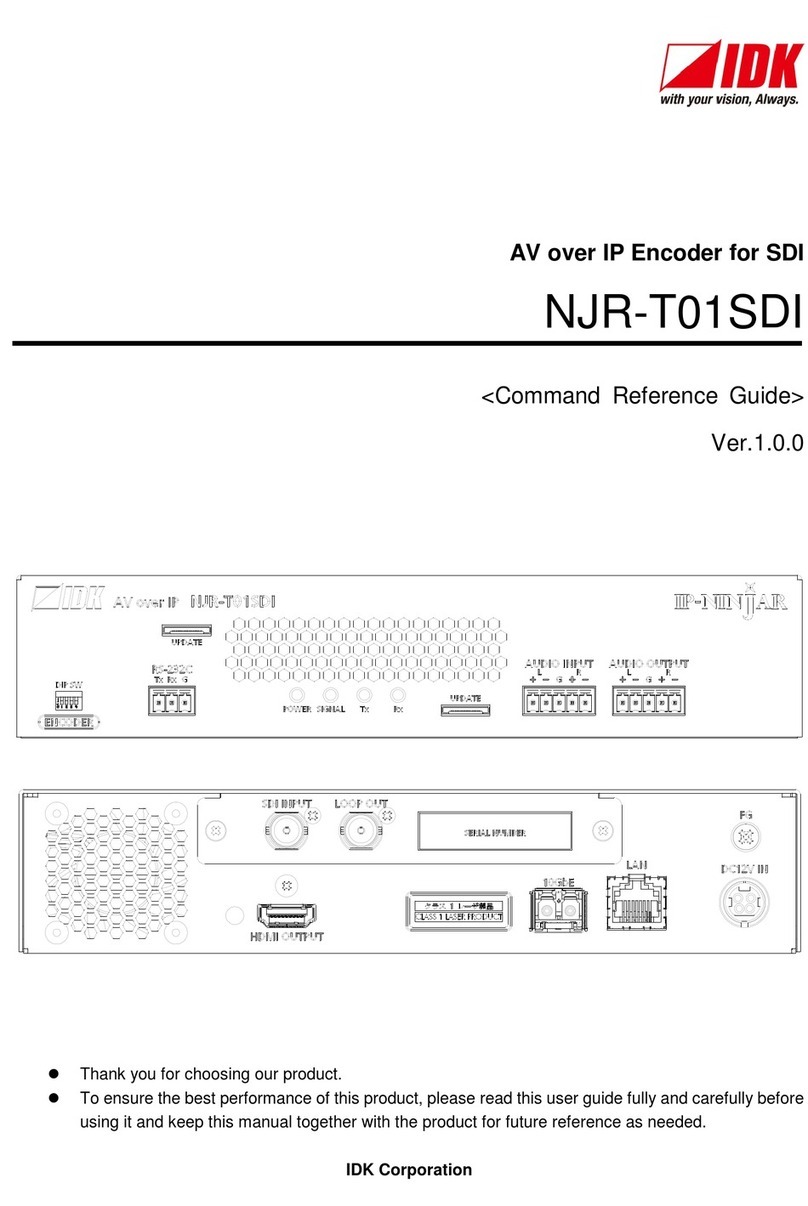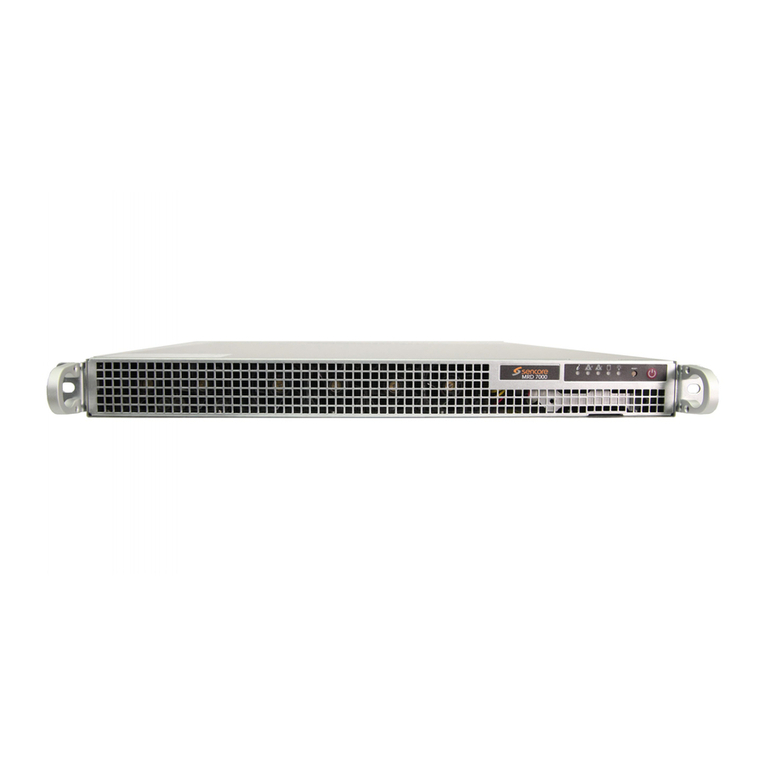R.V.R. Elettronica TRDS4002 User manual

TRDS4002
User Manual
Volume 1
Manufactured by Italy

TRDS4002 - User Manual
Version 1.0
© Copyright 2005
R.V.R. Elettronica SpA
Via del Fonditore 2/2c - 40138 - Bologna (Italia)
Telefono: +39 051 6010506
Fax: +39 051 6011104
Email: info@rvr.it
Web: www.rvr.it
All rights reserved
Printed and bound in Italy. No part of this manual may be reproduced,
memorized or transmitted in any form or by any means, electronic or
mechanic, including photocopying, recording or by any information
storage and retrieval system, without written permission of the copyright
owner.
File name: TRDS4002_en.P65
Version: 1.0
Date: 03/08/2005
Revision History
Date Version Reason Editor
03/08/05 1.0 First Version J. Berti
Notification of intended purpose and limitations of product use
This product is a FM transmitter intended for FM audio broadcasting. It utilises
operating frequencies not harmonised in the intended countries of use.
The user must obtain a license before using the product in intended country of
use. Ensure respective country licensing requirements are complied with.
Limitations of use can apply in respect of operating freuency transmitter power
and/or channel spacing.
Declaration of Conformity
Hereby R.V.R. Elettronica SpA declares that this FM transmitter is in
compliance with the essential requirements and other relevant provisions of
Directive 1999/5/EC.

TRDS4002
iUser Manual Rev. 1.0 - 03/08/05
Table of Contents
1. Preliminary Instructions 1
2. Warranty 1
3. First Aid 1
3.1 Treatment of electrical shocks 1
3.2 Treatment of electrical Burns 2
4. General Description 3
4.1 Overview of the RDS service 3
4.2 - RDS - radiodata 3
4.3 Features RDS 8
4.4 Applications 8
4.5 Definition of terms 9
5. Quick guide for installation and use 13
5.1 Installation 13
5.2 Auxiliary Equipment 13
5.3 Interconnection 14
5.3 RS232 Serial Port 14
5.4 Software 14
6. External Description 39
6.1 Front Panel 39
6.2 Rear Panel 39
7. Technical specifications 40
7.1 RDS Generator 40
7.2 Data Syncrhonization 40
7.3 Remote I/O 40
7.4 General Data 40
7.5 Connection PC - RS232 41
7.6 Sample connection Remote 41
7.7 Jumper & Dip Setting 42

TRDS4002
ii User ManualRev. 1.0 - 03/08/05

TRDS4002
1 /42User Manual Rev. 1.0 - 03/08/05
1. Preliminary Instructions
This manual is written as a general guide for those having previous
knowledge and experience with this kind of equipment, well conscious
of the risks connected with the operation of electrical equipment.
It is not intended to contain a complete statement of all
safety rules which should be observed by personnel in
using this or other electronic equipment.
The installation, use and maintenance of this piece of
equipment involve risks both for the personnel performing
them and for the device itself, that shall be used only by
trained personnel.
R.V.R. Elettronica SpA doesn’t assume responsibility for
injury or damage resulting from improper procedures or
practices by untrained/unqualified personnel in the handling
of this unit.
Please observe all local codes and fire protection standards
in the operations of this unit.
WARNING: always disconnect power before
opening covers or removing any part of this unit.
Please observe all local codes and fire protection standards
in the operations of this unit.
WARNING: this device can irradiate radio
frequency waves, and if it’s not installed following
the instructions contained in the manual and local
regulations it could generate interferences in radio
communications.
This is a "CLASS A" equipment. In a residential place this
equipment can cause hash. In this case can be requested
to user to take the necessary measures.
R.V.R. Elettronica SpA reserves the right to modify the
design and/or the technical specifications of the product
and this manual without notice.
2. Warranty
Any product of R.V.R. Elettronica is covered by a 24
(twenty-four) month warranty.
For components like tubes for power amplifiers, the
original manufacturer’s warranty applies.
R.V.R. Elettronica SpA extends to the original end-user
purchaser all manufacturers warranties which are
transferrable and all claims are to be made directly to
R.V.R. per indicated procedures.
Warranty shall not include:
1 Re-shipment of the unit to R.V.R. for repair
purposes;
2 Any unauthorized repair/modification;
3 Incidental/consequential damages as a result
of any defect;
4 Nominal non-incidental defects;
5 Re-shipment costs or insurance of the unit or
replacement units/parts.
Any damage to the goods must be reported to the carrier in
writing on the shipment receipt.
Any discrepancy or damage discovered subsequent to
delivery, shall be reported to R.V.R. Elettronica within 5
(five) days from delivery date.
To claim your rights under this warranty, you shold follow
this procedure:
1 Contact the dealer or distributor where you
purchased the unit. Describe the problem and,
so that a possible easy solution can be
detected.
Dealers and Distributors are supplied with all the information
about problems that may occur and usually they can repair
the unit quicker than what the manufacturer could do. Very
often installing errors are discovered by dealers.
2 If your dealer cannot help you, contact R.V.R.
Elettronica and explain the problem. If it is
decided to return the unit to the factory,
R.V.R. Elettronica will mail you a regular
authorization with all the necessary
instructions to send back the goods;
3 When you receive the authorization, you can
return the unit. Pack it carefully for the
shipment, preferably using the original packing
and seal the package perfectly. The customer
always assumes the risks of loss (i.e., R.V.R.
is never responsible for damage or loss), until
the package reaches R.V.R. premises. For
this reason, we suggest you to insure the
goods for the whole value. Shipment must be
effected C.I.F. (PREPAID) to the address
specified by R.V.R.’s service manager on the
authorization
DO NOT RETURN UNITS WITHOUT OUR
AUTHORIZATIONAS THEY WILL BE REFUSED
4 Be sure to enclose a written technical report
where mention all the problems found and a
copy of your original invoice establishing the
starting date of the warranty.
Replacement and warranty parts may be ordered from the
following address. Be sure to include the equipment model
and serial number as well as part description and part
number.
R.V.R. Elettronica SpA
Via del Fonditore, 2/2c
40138 BOLOGNA
ITALY
Tel. +39 051 6010506
3. First Aid
The personnel employed in the installation, use and
maintenance of the device, shall be familiar with theory
and practice of first aid.
3.1 Treatment of electrical shocks
3.1.1 If the victim is not responsive
Follow the A-B-C's of basic life support.
• Place victim flat on his backon a hard surface.
• Open airway: lift up neck, push forehead back
(Figure 1).

TRDS4002
2 / 42 User ManualRev. 1.0 - 03/08/05
• clear out mouth if necessary and observe for
breathing
• if not breathing, begin artificial breathing
(Figura 2): tilt head, pinch nostrils, make
airtight seal, four quick full breaths. Remember
mouth to mouth resuscitation must be
commenced as soon as possible.
Figura 2
• Check carotid pulse (Figura 3); if pulse is
absent, begin artificial circulation (Figura 4)
depressing sternum (Figura 5).
Figure 3 Figure 4
Figure 5
• In case of only one rescuer, 15 compressions
alternated to two breaths.
• If there are two rescuers, the rythm shall be
of one brath each 5 compressions.
• Do not interrupt the rythm of compressions
when the second person is giving breath.
• Call for medical assistance as soon as
possible.
3.1.2 If victim is responsive
•Keep them warm.
•Keep them as quiet as possible.
•Loosen their clothing (a reclining position is
recommended).
•Call for medical help as soon as possible.
3.2 Treatment of electrical Burns
3.2.1 Extensive burned and broken skin
•Cover area with clean sheet or cloth.
•Do not break blisters, remove tissue, remove
adhered particles of clothing, or apply any
salve or ointment.
•Treat victim for shock as required.
•Arrange transportation to a hospital as quickly
as possible.
•If arms or legs are affected keep them
elevated.
If medical help will not be available within an hour and the
victim is conscious and not vomiting, give him a weak
solution of salt and soda: 1 level teaspoonful of salt and 1/
2 level teaspoonful of baking soda to each quart of water
(neither hot or cold).
Allow victim to sip slowly about 4 ounces (half a glass)
over a period of 15 minutes.
Discontinue fluid if vomiting occurs.
DO NOT give alcohol.
3.2.2 Less severe burns
•Apply cool (not ice cold) compresses using
the cleansed available cloth article.
•Do not break blisters, remove tissue, remove
adhered particles of clothing, or apply salve
or ointment.
•Apply clean dry dressing if necessary.
•Treat victim for shock as required.
•Arrange transportation to a hospital as quickly
as possible.
•If arms or legs are affected keep them
elevated.
Figure 1

TRDS4002
3 /42User Manual Rev. 1.0 - 03/08/05
4. General Description
4.1 Overview of the RDS service
There is a growing, global interest, both on the part of industry, as well as
broadcasters, in information systems which utilize a data channel inserted into
radiophonic transmissions.
The interest in these new systems has been stimulated by the continuing evolution of
radio receiver technology which, with the introduction of LSI (large scale integration)
circuitry and the microprocessor, has allowed operation to be simplified and new
possibilities to be offered.
Many of these new possibilities have been developed for FM (frequency modulation)
radio where, thanks to the bandwidth available, it is possible to insert an additional
data channel onto the subcarrier, whilst maintaining compatibility with the stereophonic
transmission and remaining completely inaudible.
By transmitting channel and program identification codes on the additional data
channel, it is possible to simplify the manual tuning of receivers and even make it fully
automatic. This is of particular benefit with today’s large and continuously growing
number of FM radio stations. It is also possible to receive up-to-date traffic news and
offer other interesting features.
In the future, when radios will be fitted with voice synthesizers, it will be possible to
transmit traffic news (or other information) on the additional data channel as well as
on the regular program, as happens now, which will continue to be received
uninterrupted and independently of the data channel.
4.2 - RDS - radiodata
This system for the transmission of additional information on mono and stereo VHF
(87.5-107.5 MHz), represents the most technically advanced and, for the huge range
of possible applications, the only that has any real chance of being adopted on a
global basis.
It fulfils the various requirements needed by systems for the transmission of additional
data on radio programs, namely:
• compatibility with the main program, mono and stereo;
• absence of interference on adjacent FM channels;
• potentially better coverage area compared to mono transmissions
• compatible with other identification systems, already in service.

TRDS4002
4 / 42 User ManualRev. 1.0 - 03/08/05
Radiodata is the fruit of work undertaken by a specialized UER group, based on five
proposals formulated by Sweden, The Netherlands, Great Britain, Finland and France.
The superiority of this system results mainly from its protection from transmission
errors, crucial for in-car reception, high speed to synchronize the data groups, from
its high data rate, its potential for new applications and flexibility of use.
The spectrum of a multiplex, stereophonic signal, containing data is shown in fig.1.
Figure 1
The signal is transmitted by amplitude modulating, in suppressed carrier mode, a 57
KHz (3 times the 19 KHz pilot) subcarrier with a deviation of ± 2 KHz of the RF
carrier, retaining a maximum deviation of ± 75 KHz for the multiplex, composite audio/
data signal.
Data transmission speed is 1187.5 bit/s and, being biphase coded, produces a
spectrum of about ± 2 KHz around the 57 KHz frequency which is suppressed-
carrier modulated.
Carrier suppression is required to enable co-existance with ARI signals, since the
latter transmits information using narrow-band (about 250 Hz) DSB amplitude
modulation.
The most important waveforms produced by this modulation are shown in fig.2
below.

TRDS4002
5 /42User Manual Rev. 1.0 - 03/08/05
Figure 2
To avoid phase ambiguity on recovering the 57 KHz subcarrier, in the case of coherent
demodulation, the binary data signal undergoes differential encoding prior to biphase
encoding.
Fig.3 gives an example of the 57 KHz subcarrier after modulation by the data
signal.

TRDS4002
6 / 42 User ManualRev. 1.0 - 03/08/05
Figure 3
The system satisfies the protection ratios specified by the CCIR for mono and
stereophonic transmissions.
Figure 4: Protection ratios for FM radiophony (max. deviation: ± 75 KHz)

TRDS4002
7 /42User Manual Rev. 1.0 - 03/08/05
Fig.5 shows the protection ratio curves for the three services.
Figure 5
The structure of the data signal is shown in fig.5.
Base-band structure of Radiodata
The structural element is the “group” containing 104 bits.
Each group comprises 4 blocks of 26 bits each, of which 16 are information and 10
are for protection.
Each block is directly identifiable by an 8 bit word which is summed in module-2 with
the 10 protection bits.
The transmission is completely synchronous and there are no interruptions between
consecutive groups and blocks.
Each block is protected by a self-synchronizing, compressed, cyclical code (26,16),
having the following properties:
•detects all single and double errors;
•detects error strings of up to and including 10 bits;
•detects approximately 99.8% of error strings over 10 bits long.
The code (26,16) performs well in correcting error strings which occur frequently in
in-car reception.
All error strings of upto 5 bits can be corrected.
It should be noted that the correction of reception errors implies a finite possibility of
accepting as correct, an incorrect message that has not been detected.

TRDS4002
8 / 42 User ManualRev. 1.0 - 03/08/05
There is a choice, therefore, between simple error detection which will not recover
the message and full error correction which will do so.
From the results of reception tests carried out in Sweden, it would seem that the
optimum decoding strategy, both for domestic as well as in-car reception, requires
correction of single errors and adjacent double errors and the detection of long error
strings.
The application of the error detection and correction code is however left to the receiver
manufacturer.
4.3 Features RDS
The principal features of this encoder are as follows:
•50 PSN
•100 AF LISTE
•RS 232 C
•DATE, HOUR and CT
•RADIOTEXT
•TA - PTY - MS
•Fast tuning and switching information
•Traffic Message Channel
•Enhanced Other Network
•Linkage Information
•Lenguage Identification Code
•Extended Country Code
•Application Identifications
•Program Type Name
•19 KHz Input available on the rear panel
•Command TA - TA EON 0 - TA EON 1 - TA EON 2 - TA EON 3 - TA EON 4 - MS -
RDS OFF- remote available on the rear panel via Cannon 25 pin connector
•Enabling of transmitted groups (eg. RDS - CT - RADIOTEXT)
•Control of leap years
•RDS segnal level adjust
4.4 Applications
Radiodata (RDS) has been developed principally for transmitting tuning information,
such as the channel identifier, for the control of radio networks and the control of
basic functions of the new generation of radio receivers. It also, however, offers basic
ARI functions for in-car reception besides many interesting possibilities for domestic
radio reception.

TRDS4002
9 /42User Manual Rev. 1.0 - 03/08/05
For example, it will be possible to transmit a commentary to the main program, as a
RADIOTEXT message comprising text made up of alphanumeric characters (ASCII)
that will appear on a display integrated into the receiver, and ultimately be able to
control a voice synthesizer.
It is also possible to use Radiodata for the distribution of computer software.
It will thus be possible for software users to record software transmissions without
the inconvenience of often extended interruptions to the main program being
transmitted.
4.5 Definition of terms
THE FOLLOWING LIST OF DEFINITIONS RELATE TO THE STANDARDIZATION SPECIFICATION ANTERIOR TO THE
EBU TECHNICAL DOCUMENT - TECH. 3244 - E AND CENELEC FOR EN 50 067.
Program Identifier (PI)
This is a code which enables the receiver to distinguish the country of origin and the
identification of the transmitted program.
The most important application of this information is the ability for the receiver to
search automatically for alternative frequencies in the event of bad reception of the
program to which it is tuned.
The change of frequency happens when a better signal with the same code of PI
(program Identifier) is found.
Program Service name (PSN)
This function allows transmission of messages upto a length of eight alphanumeric
characters which can be used by the receiver to display to the listener the name of
the currently tuned station and other information.
The Program Service name is not used for automatic searching.
Traffic Program identifier (TP)
This is a function that identifies stations which transmit traffic information to drivers
by, for example, changing the colour of the receiver’s display.
Alternative Frequency list (AF)
This function allows lists comprising 25 alternative frequencies to be transmitted.
The receiver can thus hop automatically to the best reception frequency of the
transmission.
Traffic Announcement identifier (TA)
When this function is enabled by the station, the receiver will switch automatically
from cassette to radio listening.

TRDS4002
10 / 42 User ManualRev. 1.0 - 03/08/05
The car radio, as well as being tuned to the station transmitting traffic announcements,
has to be enabled to receive ARI INFO or TA.
Once the announcement has been made, the radio automatically reverts to cassette
listening. This function is analogous toARI.
Program Type (PTY)
This function allows a code corresponding to the type of program to be transmitted
with the program in order to identify it.
This service is not yet available on all receivers, but will eventually allow the receiver
to be programmed to record certain types of program.
31 categories of program have already been defined by the EBU and are listed as
follows:
0. No program type or undefined
1. News
2. Current Affairs
3. Information
4. Sport
5. Education
6. Drama
7. Culture
8. Science
9. Varied
10.Pop music
11. Rock music
12.M.O.R. Music
13.Light classics
14.Serious classics
15.Other music
16.Weather
17.Finance
18.Children's programs
19.Social Affairs
20.Religion
21.Phone-In
22.Travel
23.Leisure
24.Jazz Music

TRDS4002
11 /42User Manual Rev. 1.0 - 03/08/05
25.Country Music
26.National Music
27.Oldies Music
28.Folk Music
29.Documentary
30.Alarm Test
31.Alarm
Decoder Identifier (DI)
This function allows the identification of 16 different modes of operation including:
•monophonic transmission
•stereophonic transmission
•artificial stereophonic transmission
•processed mono
•processed stereo
•artificial processed stereo
Music / Speech (M/S)
This function allows the program to be identified as music or speech.
Compatible receivers will have two controls for independant volume adjustment of
music and speech to the listener’s preference.
Program Identification Number (PIN)
This function allows selection of program type by the listener, such as light music,
news or other.
Radiotext (RT)
This function allows the transmission of 64 characters addressed to domestic
receivers equipped with a particular display.
With in-car receivers, where it is not possible to display text for safety reasons, it
maybe possible in the future to communicate the radiotext message using a voice
synthesizer.
Other Network information (EON)
This service allows control of the TA, TP, PTY and PIN functions of ten radio networks.
Transparent Data Channel (TDC)

TRDS4002
12 / 42 User ManualRev. 1.0 - 03/08/05
This service, which is similar to Radiotext, allows serial alphanumeric information,
corresponding to computer software or other non displayable information, to be
transmitted.
Clock Time (CT)
As per CCIR standards, information relating to time and date is defined by
Coordinated Universal Time (UTC) and by Modified Julian Day (MJD).
The listener will not have direct access to this information which will be used, internally,
by the receiver.
Fast basic tuning and switching information
Fast tuning service.
Traffic Message Channel
This service is used to send traffic information through a specific channel.
Enanched Other Network (EON)
This service transmits network information.
Linkage Information (LI)
This information is transmitted together with the EON.
Lenguage Identification Code (LIC)
Language used by the radio station.
Extended Country Code (ECC)
Specify oncemore the country name in order to be recognized inequivocably beside
the information already transmitted together with the PI.
Application Identifications (AI)
Type of ODA signal to be transmitted together with the TMC.
Program Type Name (PTN)
Specify the kind of PTY (example PTY=SPORT, PTN=BASEBALL max 8 characters).

TRDS4002
13 /42User Manual Rev. 1.0 - 03/08/05
5. Quick guide for installation and use
5.1 Installation
The TRDS4002 instruction manual should be read carefully to ensure correct
use of the unit.
1. The TRDS4200 encoder`should be installed between the stereo encoder and
the transmitter.
If the audio processor is to be used with an internal encoder, the RDS signal can
be connected to the relevant connector on the encoder card.
Connections between units must be as short as possible since reactive properties
of the connection cables will produce phase shifts on the multiplexed signal that
will vary with frequency.
This will result in a reduction of stereo separation which can be severe. It is
recommended that
Connection cables do not exceed 3 metres in length.
2. Position the encoder away from sources of heat.
Avoid humid sites with extremes of temperature.
3. Check that the line voltage is suitable for the TRDS4002 before connection with
the cable supplied.
The voltage is selected internally and can be 220 VAC or 110 VAC (50/60 Hz).
4. Take care to ensure that input and output connections are made properly since, in
the majority of cases, hum and noise are caused by poor connections.
5. Never use alcohol or chemical solvents to clean the unit as these can cause
damage to the finish.
6. Should the unit appear faulty, switch off, bypass the unit and contact your nearest
RVR service center.
7. Keep this manual for future reference and to avoid possible operational error.
Failure to observe the above instructions will result in the immediate expiry
of all guarantees.
5.2 Auxiliary Equipment
The RDS signal becomes indispensable for the purpose of transmitting adverts on
separate networks.
During transmission of adverts, the signal sent to the transmitter usually is generated
by a unit that creates a pseudostereo signal which does not have the same
characteristics of the normal transmission.

TRDS4002
14 / 42 User ManualRev. 1.0 - 03/08/05
A special device is required to maintain the normal signal. This device will insert the
RDS signal to every individual transmitter.
Such a device is the RDS MIXER MKII.
5.3 Interconnection
The RDS data encoder must be connected between the stereo encoder and the
transmitter.
The stereo encoder’s multiplex output should be connected to the MPX IN input of
the RDS encoder.
The MPX+RDS OUT output should be connected to the input of the transmitter.
It is advisable to keep cable lengths to less than 3 metres.
The injection of the RDS signal has been factory-adjusted for an MPX input level of 0
dBm (and a 19 KHz pilot level of -20 dB).
For higher input signal levels, turn the “RDS LEVEL” multi-turn potentiometer
clockwise.
International standards recommend an RDS level of -31.5 dB with respect to
the stereo and consequently -11.5 dB with respect to the pilot.
No phase adjustment is required as synchronization is performed
automatically by internal circuitry.
In the event of monophonic transmissions, the RDS data encoder should be
connected between the last low frequency unit in the audio chain and the transmitter.
5.3 RS232 Serial Port
The Serial connection RS232C is standard and has a 9 poles Cannon connector.
As per each RS232 connection, the length must not be superior to 20 m and the
shielding must be adequate.
Anyway, it is possible to extend the connection at any time by using a couple of
standard line extensors.
5.4 Software
The RDS coder control program is supplied together with this handbook in CDROM
version. It must be installed on a computer with CPU Pentium 266 or better and a
Windows 95/98 version must be installed. The software cannot run without these
configurations or, in the best of cases, it will run but will not be able to communicate
correctly with the coder.

TRDS4002
15 /42User Manual Rev. 1.0 - 03/08/05
To install the program, go to the CDROM reader drive, and double click on the
Setup.exe icon.
The program will be automatically installed and a link will be created on the program
bar.
To execute the program, click on the Start button on the applications bar with the left
button of the mouse. Select the Programs file, then the Rdspcsat file. Now, using the
mouse, click on the Rdspcsat program.
The following window will appear:
An error message may be received when the program is started for the first time,
due to the default parameters set, which may not be suitable for your system. The
parameters of the serial port must therefore be modified.

TRDS4002
16 / 42 User ManualRev. 1.0 - 03/08/05
Select the RS232 icon and the following window will appear:
Let’s now see the parameters and their meaning:
- RSD Option
This is used to choose whether a coder programmed locally or via satellite is
involved.
This choice affects all the programming windows and disables or enables certain
functions.
In the case of programming "via satellite", only the transmission function is available
therefore all the reading push buttons will be disabled. A new push button called
BURST will also be enabled, which automatically repeats the transmission performed
a number of Times, equal to that set in the specific option.
This performance has been implemented to overcome the problem of any "MTF’s"
transmitted with the consequent incompleteness of the parameters sent.
- BURST
3 Times 4 Times ..... 10 Times as explained above, this parameter takes care of the
transmission, repeating it 3, 4 ....10 times.
- LANGUAGE
Choice of the operational language.
- AUTOSETTING
This push button is enabled only in the “Local” configuration and automatically
Table of contents
Other R.V.R. Elettronica Media Converter manuals
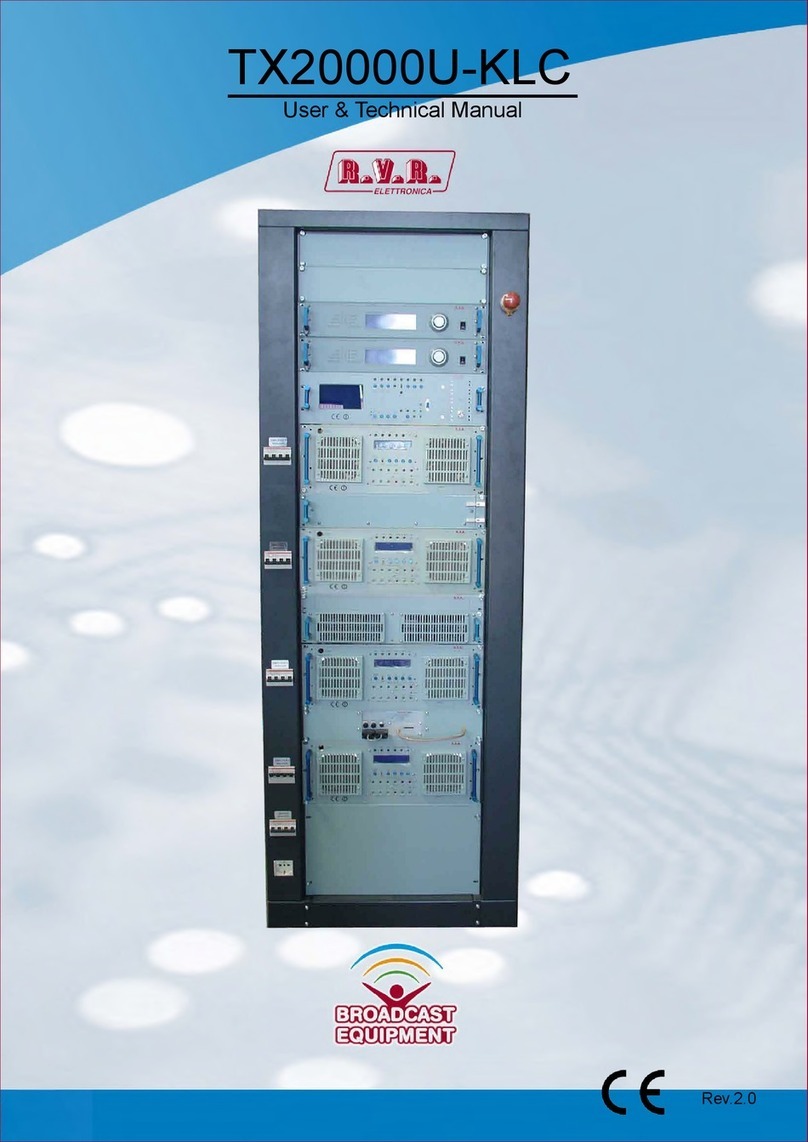
R.V.R. Elettronica
R.V.R. Elettronica TX20000U-KLC User manual

R.V.R. Elettronica
R.V.R. Elettronica TRDS 4001 User manual
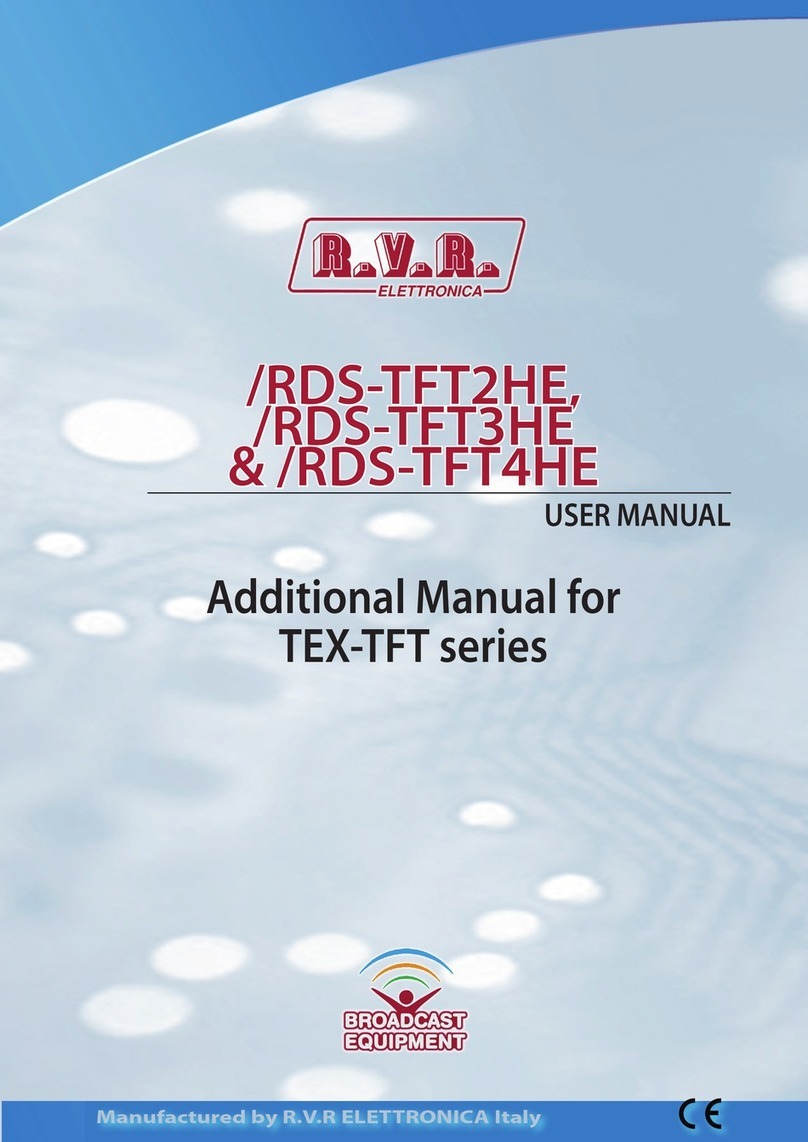
R.V.R. Elettronica
R.V.R. Elettronica TEX-TFT Series User manual
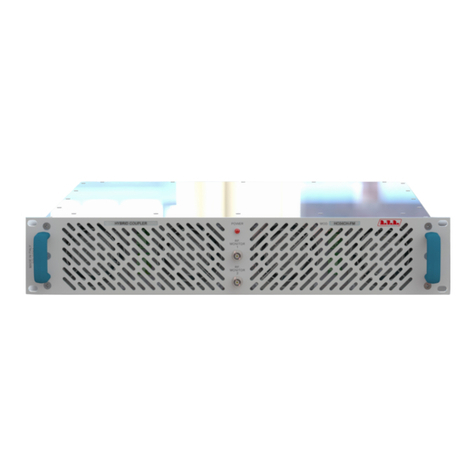
R.V.R. Elettronica
R.V.R. Elettronica HC04CH-FM User manual

R.V.R. Elettronica
R.V.R. Elettronica PTX-DDS User manual

R.V.R. Elettronica
R.V.R. Elettronica TX05KSS/61D082B User manual
Popular Media Converter manuals by other brands

Kenton
Kenton PRO SOLO mk3 operating manual

aci
aci ACCESS series Installation & operation instructions

Apantac
Apantac DA-HDTV-SDI user manual
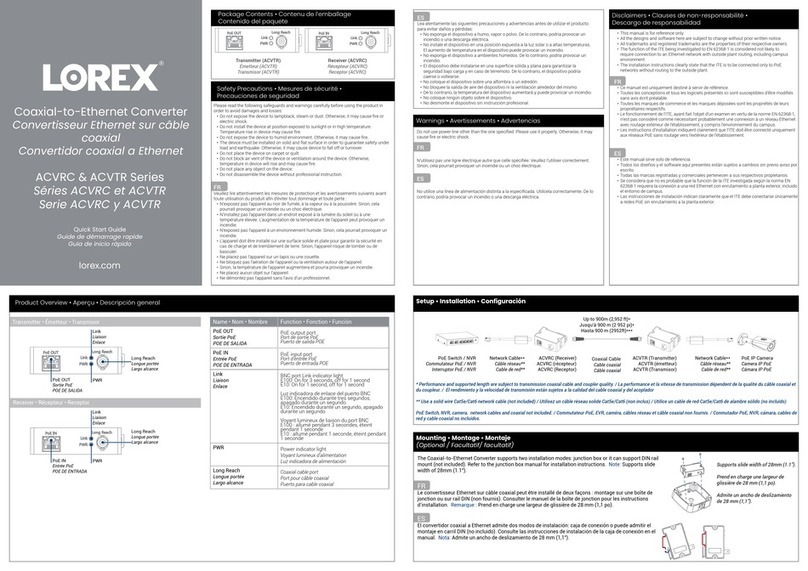
Lorex
Lorex ACVRC Series quick start guide
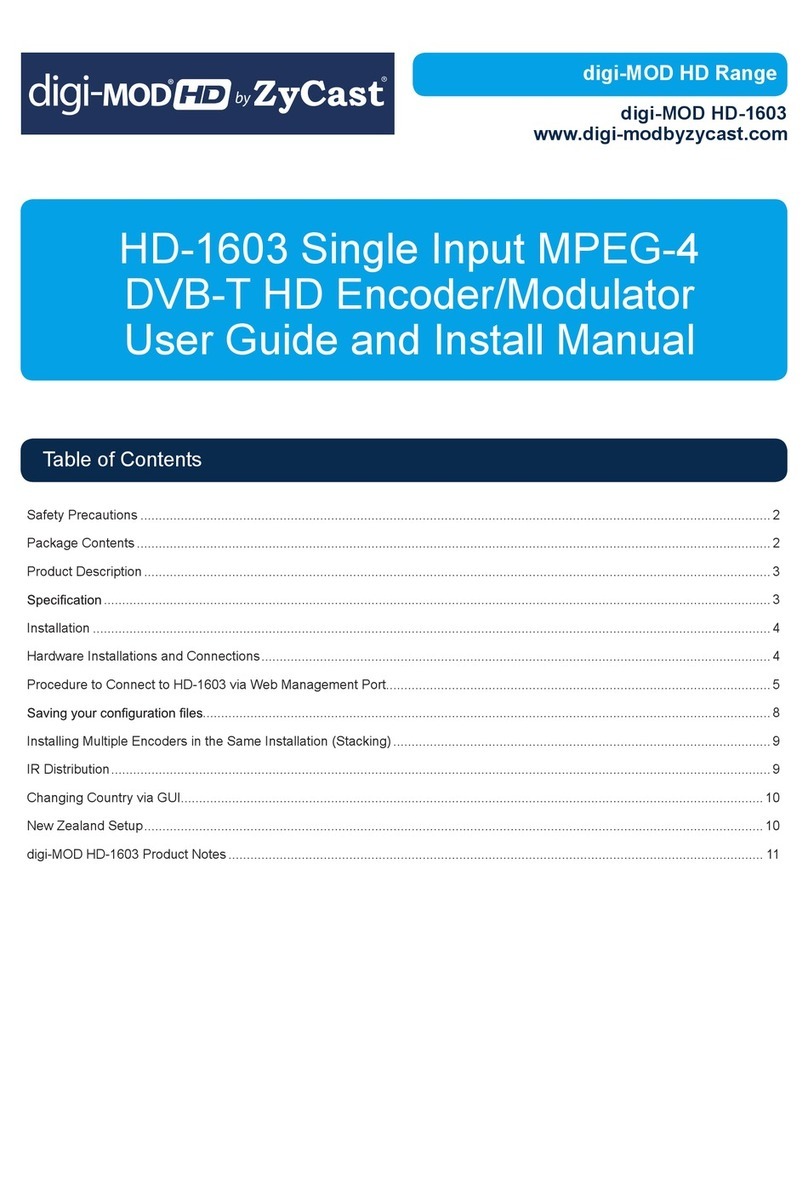
ZyCast
ZyCast digi-MOD HD-1603 User guide and installation manual
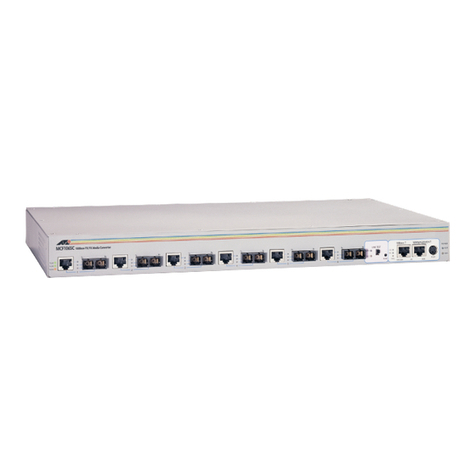
Allied Telesis
Allied Telesis AT-MCF106ST installation guide
